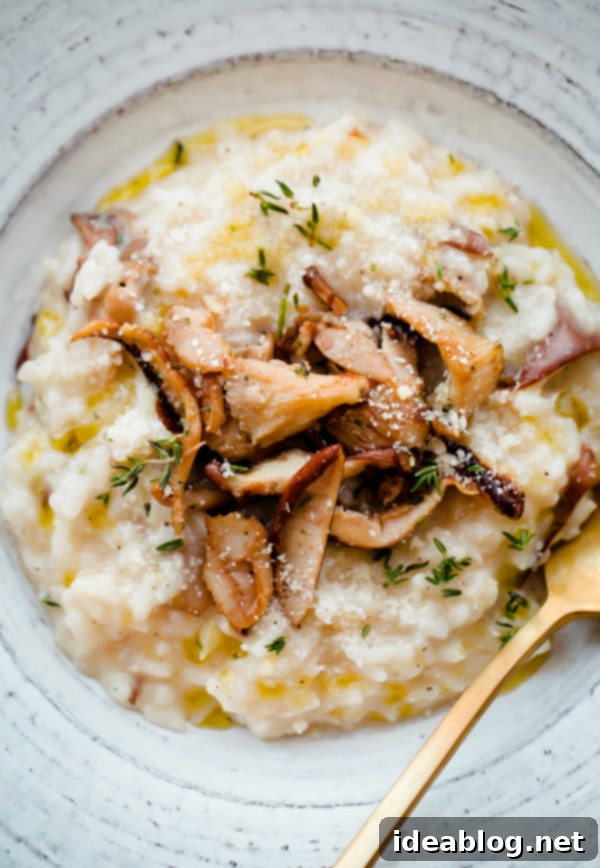Effortless Creamy Mushroom Risotto: The Ultimate No-Stir Recipe for Weeknights
Tired of being chained to the stove, stirring continuously to achieve that perfectly creamy risotto? This revolutionary no-stir mushroom risotto recipe is here to transform your cooking experience! Discover how to create a luxurious, restaurant-quality vegetarian main course for weeknights or special occasions with minimal effort and maximum flavor. Prepare to be amazed by a dish that delivers all the rich, comforting taste of classic risotto without the constant stirring.
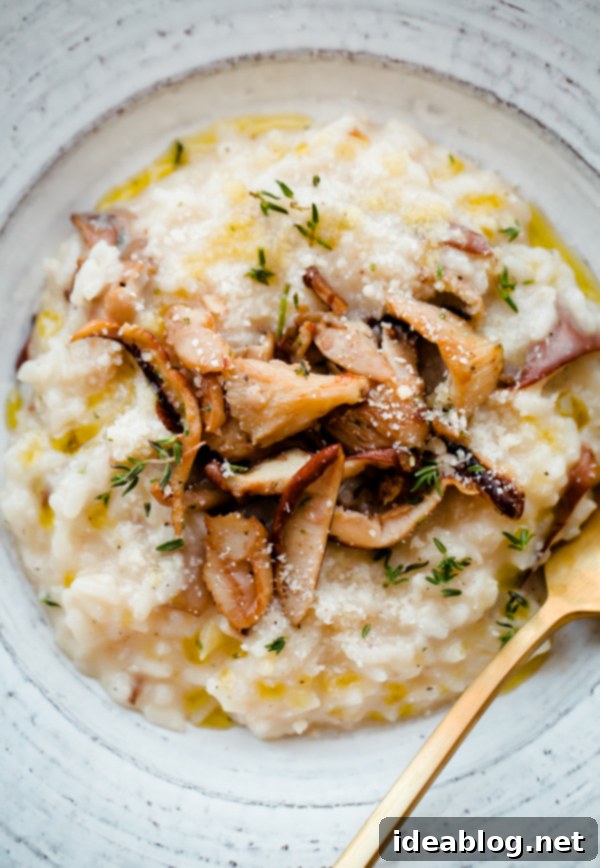
Embrace Convenience: The Magic of No-Stir Risotto
Risotto holds a special place in the hearts of many food enthusiasts. Its signature creamy texture and ability to carry a myriad of flavors make it a truly satisfying dish. However, the traditional method often deters home cooks due to its perceived complexity and, more significantly, the relentless requirement for constant stirring. For many, this makes risotto a weekend indulgence rather than a practical weeknight meal. But what if we told you that you could achieve the same velvety smooth result with dramatically less fuss?
This “no-stir” risotto technique is a game-changer. It means you no longer have to stand over the stovetop, spoon in hand, for 20-30 minutes. Imagine preparing a sophisticated, hearty meal while still having time to chat with family, set the table, or simply relax. This method liberates you from the stove, making creamy mushroom risotto genuinely weeknight-friendly.
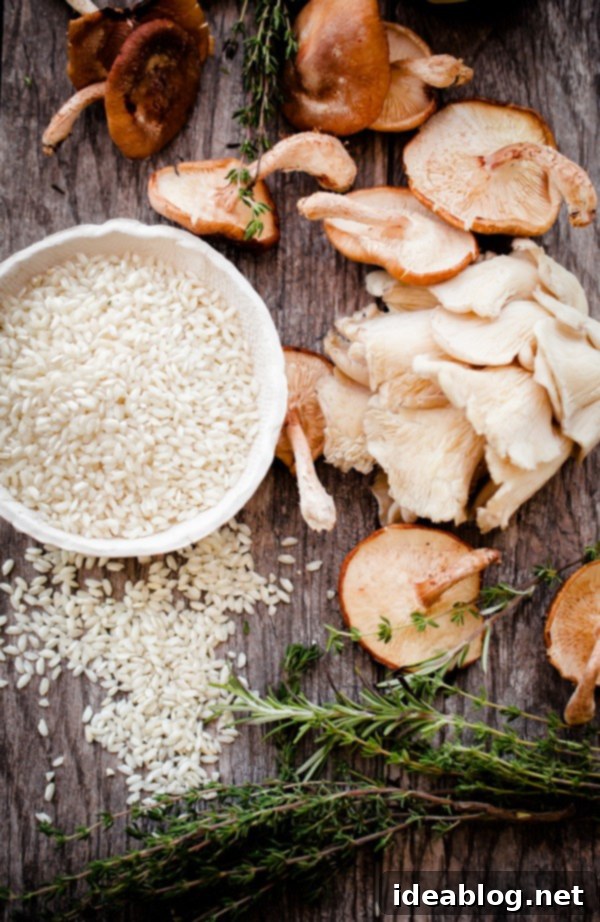
Deconstructing Classic Risotto vs. The No-Stir Method
To fully appreciate the innovation of no-stir risotto, it helps to understand the traditional approach. Classic Italian risotto begins by toasting specific short-grain rice varieties, like Arborio or Carnaroli, in fat. Hot broth is then gradually added, ladle by ladle, allowing each addition to be fully absorbed before adding the next. This slow, steady process, combined with continuous stirring, is crucial for coaxing the starch out of the rice grains. This released starch is what ultimately creates the characteristic creamy texture that defines a perfect risotto.
About a month ago, while exploring new culinary techniques, I stumbled upon Cook’s Illustrated’s ingenious method for an “almost hands-free” risotto. Having heard whispers of similar techniques, I was immediately intrigued but skeptical. Could it truly replicate the richness and creaminess of a traditionally stirred risotto? I felt it was high time to put this method to the test myself and share the exciting results.
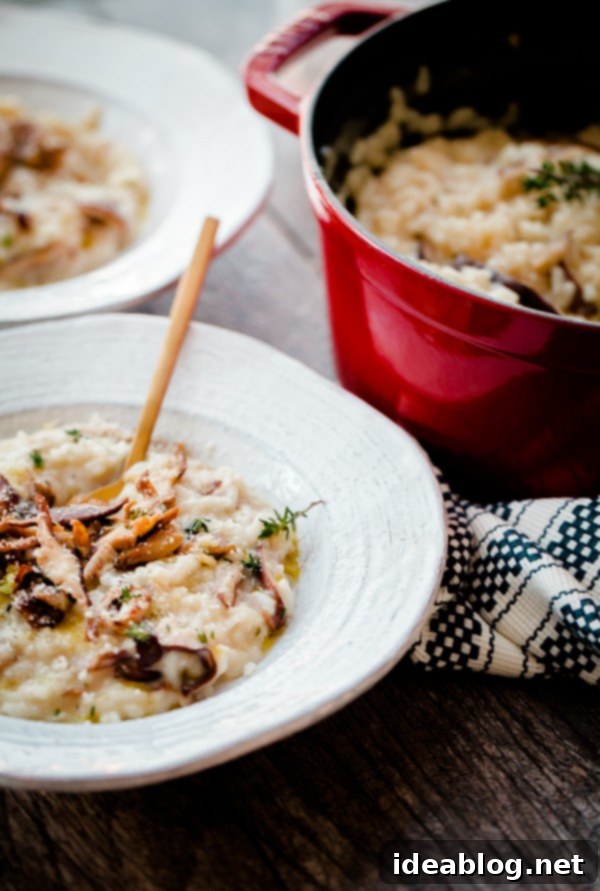
Choosing Your Rice: Arborio vs. Carnaroli
While the Cook’s Illustrated method provided a fantastic foundation, I always enjoy experimenting and refining recipes to my taste. One significant modification I made was switching the rice. Though Arborio rice is the most common and widely available variety for risotto, my personal preference, and indeed my go-to choice for homemade risotto, is the lesser-known Carnaroli rice. Often hailed as the “caviar” of all rices, Carnaroli truly elevates the risotto experience.
If you can find Carnaroli rice at your local grocery store (I’ve had luck finding it in the bulk bins at Whole Foods, and specialty Italian stores are a reliable source), I wholeheartedly recommend it over classic Arborio. This particular insight came to me years ago during culinary school tours, and it’s a tip I’ve sworn by ever since.

What makes Carnaroli rice so superior for risotto? It is notably starchier than Arborio, which translates directly into an even creamier, more luxurious final dish. Beyond its starch content, Carnaroli rice also boasts superior structural integrity, holding its shape far better during the cooking process. The ideal risotto should feature grains that are still distinct, firm, and slightly ‘al dente’ once cooked, rather than dissolving into a mush. Carnaroli excels at this.
Think of it like investing in high-quality dried pasta over a cheaper alternative. The initial investment in Carnaroli rice invariably leads to a superior outcome, offering a more refined texture and richer flavor. Moreover, it’s far more forgiving during cooking, making it an excellent choice for both beginners and seasoned chefs.
However, if Carnaroli rice isn’t accessible, don’t fret! You can absolutely use Arborio rice for this dish and still achieve fantastic results. The no-stir method itself is transformative, regardless of your rice choice. To infuse this risotto with even more depth and ‘oomph,’ I incorporated sautéed mushrooms and fresh herbs during the final stages. These mushrooms can be expertly prepared either while the risotto simmers or even ahead of time for added convenience. For this recipe, I opted for a flavorful blend of shiitake and oyster mushrooms, but feel free to experiment with your favorite varieties, like cremini or porcini, for a personalized touch.
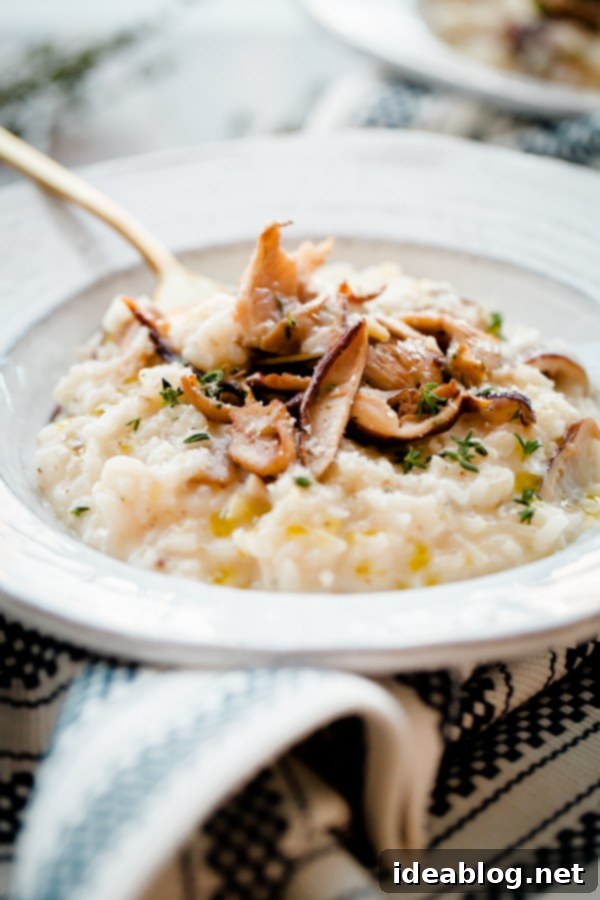
Mastering the No-Stir Technique: Simple Steps to Creamy Perfection
The ingenuity of this no-stir mushroom risotto lies in a clever deviation from the traditional method, allowing for a remarkably hands-off cooking experience. You begin as you would with any classic risotto: sautéing finely diced onion until translucent, toasting the rice until its edges become slightly clear, and deglazing the pan with dry white wine, letting the rice absorb its aromatic essence.
Here’s where the magic happens and the method diverges significantly. Instead of gradually adding broth, you pour in a substantial quantity (5 cups) of hot stock all at once. After a quick stir, the heat is reduced to a low simmer, and the pot is covered. The risotto is then allowed to cook undisturbed for 15 to 18 minutes. Crucially, during this period, you only lift the lid and stir once or twice – no more, no less – simply to ensure even cooking and prevent sticking, adjusting the heat as needed to maintain a gentle simmer. This brief intervention is a far cry from constant stirring and allows you to attend to other tasks, like preparing your delicious mushroom topping.
Finally, in the last 3 to 5 minutes of cooking, you return to the pot for a concentrated period of gentle, continuous stirring. This final burst of agitation is what truly helps release the last of the rice’s starches, developing that incredibly creamy, luxurious texture we all crave in a perfectly executed risotto. It brings all the elements together into a cohesive, comforting dish.
While the ritual of constant stirring in a classic risotto certainly has its meditative appeal, I can confidently say that this “hands-free” mushroom risotto has become my new go-to for convenient and delicious weeknight dinners. It’s also an absolute lifesaver when entertaining a larger group, especially more than just a couple of people. This method allows you to step away from the stove, mingle with your guests, and truly enjoy their company, rather than being tethered to a simmering pot. It’s rich, flavorful, and wonderfully versatile, proving that exceptional taste doesn’t always demand exceptional effort.

Easy No Stir Mushroom Risotto
Pin
Review
SaveSaved!
Ingredients
- 5½ cups (1.3 L) low-sodium chicken broth
- 1½ cups (360 mL) water
- ¼ cup (2 oz; 60 g) unsalted butter divided
- 1 large yellow onion very finely diced
- kosher salt
- 1 large garlic clove finely minced
- 2 cups (360 g) carnaroli rice or arborio (see notes)
- 1 cup (240 mL) dry white wine such as Pinot Grigio
- 3 ounces grated parmigiano-reggiano cheese plus more for serving
- sautéed mushrooms and herbs see recipe below
- 1 teaspoon fresh lemon juice
- freshly ground black pepper
Sautéed Mushrooms and Herbs:
- 2 tablespoons (30 mL) extra virgin olive oil
- 1 tablespoon (15 g) unsalted butter
- 8 ounces (½ lb) fresh shiitake mushrooms stems discarded and caps thinly sliced
- 8 ounces (½ lb) oyster mushrooms tough stems discarded and sliced
- 2 medium garlic cloves finely chopped
- ¼ cup (60 mL) dry white wine such as Pinot Grigio
- 2 teaspoons freshly chopped thyme leaves plus more for garnishing
- 1 teaspoon freshly chopped rosemary leaves
- kosher salt
- freshly ground black pepper
Instructions
-
1. Prepare the Risotto Base: Combine the chicken stock and water in a medium saucepan. Bring the mixture to a very low simmer and keep it hot over low heat while you prepare the rice.
-
In a large Dutch oven or heavy-bottomed pot, melt 2 tablespoons of the unsalted butter over medium heat until it’s lightly bubbling. Add the very finely diced onion along with a generous pinch of salt. Sauté for 5 to 7 minutes, stirring occasionally, until the onion is very soft and translucent. Stir in the minced garlic and sauté for another 30 seconds to 1 minute, until fragrant. Add the carnaroli (or arborio) rice and toast, stirring constantly with a wooden spoon, for 2 to 3 minutes until the individual rice grains appear slightly translucent around their edges.
-
Pour in the dry white wine and continue to cook for 2 to 3 minutes, stirring, until the wine has been completely absorbed by the rice. Now, add 5 cups (1.2 L) of the hot broth mixture to the pot, give it a good stir, reduce the heat to low, cover the pot tightly, and let it simmer for 15 to 18 minutes. During this simmering period, remove the lid and stir the risotto only twice, adjusting the heat as necessary to maintain a very low, gentle simmer.
-
2. Prepare the Sautéed Mushrooms: While the risotto is simmering, prepare your mushrooms. Heat a very large sauté pan (the more surface area, the better for browning) over high heat. Add the olive oil and 1 tablespoon of unsalted butter. Once shimmering, add the sliced mushrooms, spreading them into a single layer with a wooden spoon. Sauté the mushrooms for 3 to 5 minutes, stirring only occasionally, until they have deeply caramelized and a nice light brown fond (browned bits) has formed on the bottom of the pan. Add the chopped garlic and stir until fragrant, about 30 seconds.
-
Remove the pan from the heat and deglaze it with ¼ cup of dry white wine, scraping up any browned bits from the bottom. Return the pan to the heat, add the freshly chopped thyme and rosemary, and continue to cook until all the white wine has evaporated. Season the sautéed mushrooms generously with kosher salt and freshly ground black pepper to taste. Set aside.
-
3. Finish the Risotto: Once the risotto has finished its covered simmering, remove the lid. Add the remaining 1 cup (240 mL) of hot broth and stir gently and continuously with a wooden spoon for 3 to 5 minutes, or until the risotto has become wonderfully creamy and thickened considerably. Stir in the grated Parmigiano-Reggiano cheese until it’s evenly incorporated. Remove the pot from the heat, cover, and allow it to sit for 5 minutes. Stir in the remaining 2 tablespoons of butter, fresh lemon juice, and most of the sautéed mushrooms. I like to reserve a small amount of mushrooms for garnishing each individual serving. If the risotto has become too thick for your preference, add a bit more of the remaining hot broth (or water) until it reaches your desired consistency. Ideally, risotto should be loose enough that it flows gently when tilted in a bowl or plate (the “all’onda” consistency).
-
4. Serve: Season the finished risotto to taste with additional salt and freshly ground black pepper. Serve immediately in pre-warmed bowls or plates. Garnish each portion with the reserved sautéed mushrooms, a sprinkle of freshly grated Parmigiano-Reggiano cheese, and a few fresh thyme leaves for an aromatic finish. Enjoy your perfectly creamy and effortless mushroom risotto!
Tips for Success:
- Rice Choice Matters: For the best texture and flavor in your risotto, I highly recommend using Carnaroli rice if you can find it. It’s known for its higher starch content and ability to maintain its shape, resulting in a creamier, more ‘al dente’ risotto compared to Arborio. Check specialty Italian stores or the bulk bins at some high-end grocery stores like Whole Foods.
- Broth Temperature: Always ensure your broth mixture is simmering and hot when added to the rice. Adding cold broth will significantly lower the temperature of the risotto, disrupting the cooking process and potentially leading to uneven results.
- Mushroom Varieties: Feel free to experiment with different types of mushrooms! While shiitake and oyster mushrooms provide a wonderful depth of flavor, cremini, portobello, or even wild mushrooms can be used for varied taste profiles.
- Deglazing for Flavor: Don’t skip the deglazing step for the mushrooms! The dry white wine helps to scrape up all those flavorful browned bits (fond) from the pan, adding another layer of complexity to your dish.
- Seasoning: Taste and adjust seasoning as you go. Risotto requires careful seasoning with salt and pepper at various stages to build flavor.
- Al dente Consistency: Aim for rice that is tender but still has a slight bite in the center – this is the hallmark of a perfectly cooked risotto.
- Serve Immediately: Risotto is best enjoyed fresh off the stove. Its creamy texture can stiffen as it cools, so serve it piping hot in pre-warmed bowls.
Adapted from Cook’s Illustrated.
